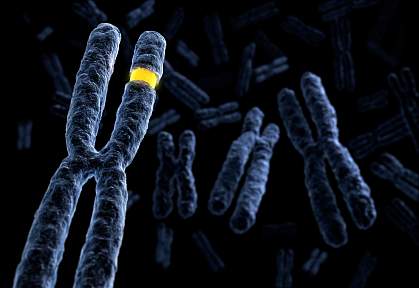You are here
May 14, 2012
Chromosome Quirks Linked to Aging and Cancer

Large structural abnormalities in chromosomes become more common with age and may be linked to increased risk for cancer, according to 2 large-scale analyses. The findings offer insights into how cancer and other disorders might emerge as people get older.
Previous studies suggest that a type of structural abnormality in chromosomes called genetic mosaicism may play a role in certain health conditions such as miscarriages, birth defects and some cancers. Genetic mosaicism can arise when portions of chromosomes—or even entire chromosomes—are deleted or duplicated as a cell divides. These altered chromosomes might be created during embryonic development or later in life. When cells with altered chromosomes persist, a person can develop a mixture of both normal and mutated cells.
The frequency of mosaicism and its relationship to health conditions in the general population have been unclear. In the 2 new studies, independent research teams analyzed data from genome-wide association studies (GWAS) and looked for the presence of mosaicism and its association with cancers. The studies appeared together on May 6, 2012, in the advance online edition of Nature Genetics.
One study, led by scientists at NIH’s National Cancer Institute (NCI), examined data on 31,717 people with cancer and 26,136 cancer-free controls from 13 GWAS. In the cancer-free group, the frequency of mosaicism increased with age (from 0.23% for those under age 50 to 1.91% between ages 75 and 79). The scientists also found that mosaicism was more common in people with solid tumors than in cancer-free participants (0.97% vs. 0.74%).
The other study examined data from more than 50,000 participants in the Gene Environment Association Studies (GENEVA) consortium. The research was sponsored by NIH’s National Human Genome Research Institute (NHGRI). The scientists found that the rate of mosaic abnormalities in the bloodstream was low (less than 0.5%) from birth to age 50. After that, the frequency climbed sharply, rising to 2% to 3% in the elderly.
Both studies detected increased genetic mosaicism in a subset of patients who were later diagnosed with certain cancers of the blood, including leukemia, lymphoma and myeloma. The GENEVA researchers estimate that having these chromosomal abnormalities might increase chances 10-fold for later developing blood cancer. The scientists, though, stress that these findings will need to be confirmed in additional studies.
“These 2 studies provide large population-based evidence that genetic mosaicism increases with age and could be a risk factor for cancer,” says Dr. Stephen Chanock of NCI, a co-author of both papers. “This last point raises an important issue with respect to the stability of a person's genome and suggests that detection of genetic mosaicism could be an early marker for detecting cancer, or perhaps other chronic diseases.”
Related Links
References: Nat Genet. 2012 May 6. doi: 10.1038/ng.2270. [Epub ahead of print] Nat Genet. 2012 May 6. doi: 10.1038/ng.2271. [Epub ahead of print]
